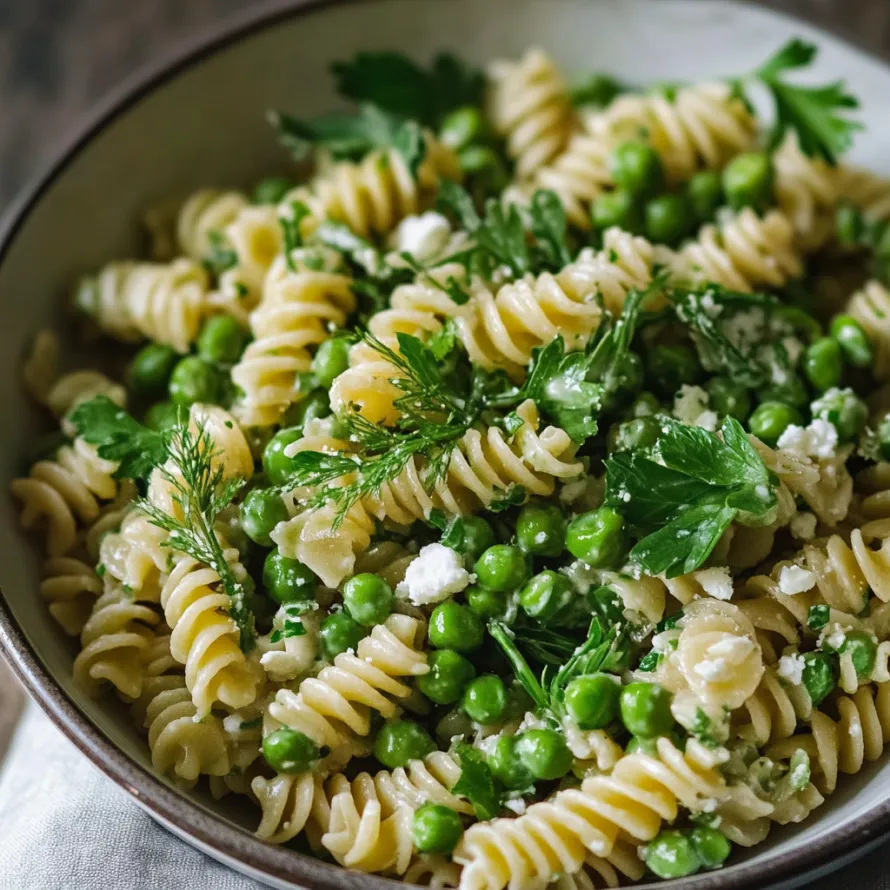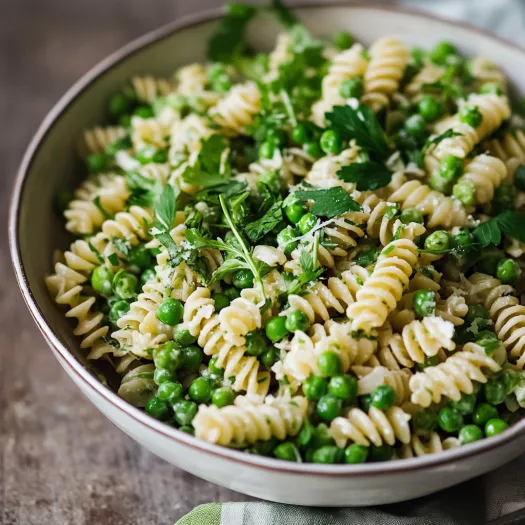 Save
Save
This garden-fresh pea pasta turns basic ingredients into a lively springtime meal that brings out the best of what's in season. Sweet peas, cool mint, and fancy truffle oil work together to create a dish you'd think came from your favorite restaurant, but it's ready in just minutes.
I came up with this dish after wandering through a local farmers market loaded with spring peas. I tossed them with pasta and whatever herbs were growing in my backyard that evening. The mix turned out so incredible that we now kick off spring with this meal every year without fail.
Ingredients
- Pasta: Go for shapes like farfalle or orecchiette that'll trap those little peas in their corners
- Fresh peas: They're the main attraction with their sweet taste and slight pop when you bite them
- Shallot: Gives a soft flavor base that makes everything else taste better
- Scallions: Add just enough onion flavor without taking over the delicate peas
- Fresh mint: Adds a refreshing touch that works wonders with peas
- Italian parsley: Brings a crisp herb flavor that cuts through the richness
- Lemons: You'll need both the zest and juice to wake up the whole dish
- Olive oil: Don't skimp here – grab the good stuff for better taste
- Pea shoots or greens: They look pretty and add a nice crunch
- Truffle oil: Just a tiny bit turns this simple pasta into something special
- Optional goat cheese crumbles: Throw some in for a tangy, creamy touch if you want
Step-by-Step Instructions
- Prepare the pasta:
- Get a big pot of water bubbling and add salt until it tastes like seawater. This step really matters for tasty pasta. Cook your pasta following the package times until it's still a bit firm. Keep in mind it'll soften up a bit more after draining.
- Prep the produce:
- While your pasta's cooking, get all your fresh stuff ready. Cut the scallions into thin slices, using every bit from white to green for the most flavor. Chop the shallot into tiny pieces so it spreads evenly through the dish. Pick the leaves from your mint and parsley and chop them up. Grab your lemons and get both the zest and juice – the zest has tons of flavor in its oils.
- Blanch the peas:
- When the pasta's almost done, toss your fresh peas right into the same pot for the last minute. This quick cook keeps them bright green with a nice little crunch. If you're using frozen peas, they need even less time – just half a minute will do.
- Create the sauce:
- Drain everything and put it back in the hot pot (but off the heat). Right away, pour in your olive oil and lemon juice while everything's still hot so the pasta soaks up all that goodness. Throw in some salt and pepper immediately.
- Finish the dish:
- Mix in your greens, herbs, shallot, scallions and lemon zest while the pasta's still warm. The heat will gently soften the greens and release all the good smells from your herbs. Toss it all together so every flavor gets to know the others.
- Final seasoning:
- Give it a taste and add whatever it needs. You'll probably want more salt than you think as the pasta keeps soaking up flavors. Add an extra squeeze of lemon if it needs some brightness. Just before serving, put a tiny drizzle of truffle oil on top for that amazing smell.

The mint is truly what makes this dish special. I grow many types in my garden, but sweet mint or spearmint pairs best with the peas. My daughter turned up her nose at first, but now she asks for this pasta as soon as she spots the first peas at our local market.
Serving Suggestions
This bright pasta works great as the main attraction with just a simple green salad and some crusty bread on the side. If you want something heartier, try adding some grilled chicken or seared scallops on top. The fresh flavors taste amazing with a cold glass of Sauvignon Blanc or Pinot Grigio, which really bring out all those herby notes.
Seasonal Adaptations
Fresh spring peas work best, but you can enjoy this pasta any time of year with a few tweaks. When it's cold out, frozen peas work great since they're picked and frozen when perfectly ripe. In summer, throw in some halved cherry tomatoes and swap some mint for basil. During fall, add some roasted butternut squash chunks for extra sweetness and substance.
Make It Ahead
This pasta tastes best right away when the herbs are super fresh and you can really smell that truffle. But you can get everything ready earlier in the day if needed. Just store your chopped herbs and veggies in separate containers in the fridge. When you're hungry, just cook the pasta and mix it all together for a quick meal that tastes freshly made.

Made with just a few simple touches, this bright pasta will become your springtime favorite that you'll make again and again.
Common Recipe Questions
- → Is it okay to use frozen peas?
Absolutely, frozen peas can be used instead of fresh ones. Just toss them into the pasta water right before draining. There’s no need to defrost them since they’ll heat up in seconds.
- → What works as a truffle oil swap?
If you’re out of truffle oil, try drizzling some olive oil with a hint of garlic or mushroom for a similar rich vibe. Even a splash of mushroom broth can offer a nice touch. It’ll be a bit different but still tasty.
- → Do I serve it warm or chilled?
This dish tastes best warm right after cooking. However, you can serve it at room temperature too. If you do, keep a little extra dressing handy to freshen it just before serving.
- → What can I replace pea shoots with?
Baby spinach or arugula would work just as well for the fresh green element. Watercress or tender kale also make great stand-ins with their peppery notes.
- → How can I make it vegan?
Leave out the optional goat cheese, and you’re good to go. Ensure your truffle oil doesn’t include any dairy additives, which some specialty brands might have.
- → What shape of pasta is best?
Medium-sized pasta like fusilli, farfalle, or orecchiette is ideal for catching the peas and herbs. That said, any shape you like—spaghetti, penne—will pair beautifully with the flavors.
